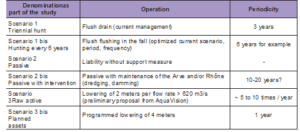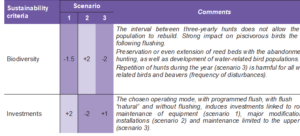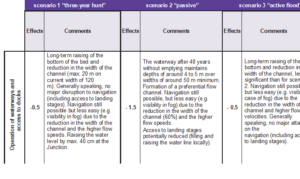
This research thoroughly investigates the multifaceted challenges of sediment management at the Verbois Dam, a project that intersects technical, financial, social, and environmental dimensions. Recognizing the intricate nature of this task, the Services Industriels de Geneve (SIG) adopted a holistic approach that transcends traditional hydraulic methodologies. The primary aim was to develop a comprehensive decision support tool that encompasses two integral components: an analysis grid for assessing effects and a grid for evaluating durability. These elements work in tandem to facilitate a detailed scrutiny and assessment of current sediment evacuation tactics. Additionally, the tool’s adaptable architecture permits the exploration and refinement of novel management strategies. The findings of this study endeavor to make a substantial contribution to the sustainable handling of sediment in dam operations, effectively marrying technical efficacy with wider environmental and social considerations.
Copyright © 2023 T. Rubin. This is an open access article distributed under the Creative Commons Attribution License, which permits unrestricted use, distribution, and reproduction in any medium, provided the original work is properly cited.
This expansive study, initiated by Geneva Industrial Services (SIG) in partnership with the Territorial Department, represents a collaborative endeavor spearheaded by the Office of Works and Environmental Studies (BTEE) and B+C Engineers SA. It brought together a multidisciplinary team of six entities, including engineers and specialists in various fields. The study’s primary objective was to establish a comprehensive decision-making framework for sediment management at the Verbois Dam. This framework was designed to facilitate informed decision-making by systematically identifying and evaluating key components of sediment management strategies [1].
Emphasizing a holistic approach, the study incorporated a detailed impact analysis and assessment module (illustrated in Figure 1). This module integrates various evaluation tools, including quantified evaluation grids complemented by informative graphical representations such as fever and radar curves. These tools provide a nuanced understanding of the environmental, technical, and socio-economic implications of sediment management practices.
Notably, the study abstains from endorsing specific strategies or providing weighted conclusions. Instead, it presents a transparent and objective analysis, offering a range of scenarios through meticulously commented and quantified data. This approach ensures that decision-makers are equipped with unbiased, comprehensive information, enabling them to consider a spectrum of possibilities and implications before arriving at sustainable and effective sediment management strategies [2].
The outcome of this study is expected to significantly contribute to the field of sediment management, particularly in the context of dam operations. It provides a replicable model for addressing complex environmental challenges, balancing technical feasibility with ecological and societal considerations.

Figure 1: Sediment removal scenarios from the Verbois dam(Services Industriels de Genève GIS basic data)
Traditional scientific and technical research focusing on flushing in the Geneva Rh\^{o}ne has predominantly concentrated on specific aspects such as fish survival and sediment quality. While these studies have been instrumental in deepening understanding of critical parameters and advancing sediment management techniques, they often fell short in providing an integrated perspective that encapsulates economic, societal, and environmental dimensions. Addressing this gap, our study undertakes a holistic analysis of various flushing-emptying scenarios in the context of sustainable development. This approach emphasizes early risk detection and conflict identification, thereby enhancing strategies for sustainable progress [3].
To tackle the multifaceted nature of this challenge, a specialized expert group was convened. This group, comprised of seasoned professionals, undertook an objective evaluation of data and insights provided by the Services Industriels de Gen\`{e}ve (SIG) and the Territorial Department. Their collective expertise facilitated a nuanced and comprehensive understanding of the intersecting factors influencing sediment management and its broader implications [4].
The methodology employed in this study involved a meticulous selection of domains and identifying key components, each influenced by various factors. This process entailed the careful selection of sustainability criteria, drawing upon the Swiss Federal Council’s 2002 guidelines for sustainable development, while tailoring these criteria specifically to the nuances of flushing-emptying processes [5].
The study then proceeded with an in-depth analysis of effects, which offered valuable insights into the impacts and potential enhancements associated with different scenarios. This step was crucial in understanding the various implications of each variant under consideration.
Finally, the study conducted a comprehensive sustainability evaluation. This involved correlating the observed effects and identifying any conflicts, all within the tripartite framework of sustainable development. This evaluation aimed to discern the pros and cons of each project variant, while also pinpointing areas for potential improvement. By doing so, the study strived to present a balanced view, encompassing the intricate interplay of environmental, economic, and social factors integral to sustainable development.

Figure 2: Determining components retained for the analysis of effects.
Similarly, their transposition onto the cardinal scale involves indicators, standards, and benchmarks currently absent. It was also considered reasonable to justify the results of the expertise using key elements of the project and the context that strongly influence the criterion in question.
Figure 3: Extract from the sustainability analysis table

Figure 4: Extract from the effects analysis table